Creator God - Quetzal Bird, Feathered Serpent (DNA)
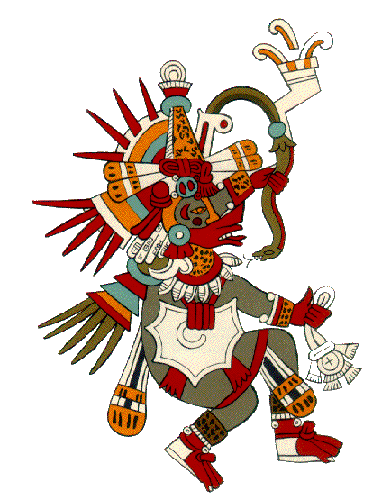
God of Civilization and Learning
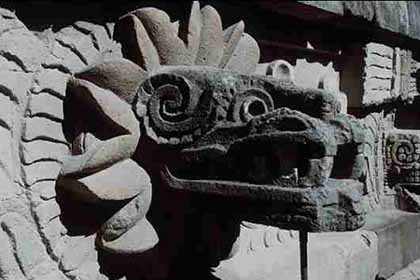
Good of Agriculture - The Road Sweeper
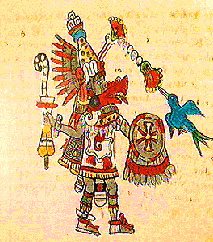
PATECATLl
PAYNAL
Creator God - Quetzal Bird, Feathered Serpent (DNA)

God of Civilization and Learning

Good of Agriculture - The Road Sweeper

It was the name of a deity, a royal title, the name of a legendary priest-ruler, a title of high priestly office. But its most fundamental significance as a natural force is symbolized by the sculpture of a coiled plumed serpent rising from a base whose underside is carved with the symbols of the earth deity and Tlaloc.
The image of the serpent rising from the earth and bearing water on its tail is explained in the Nahuatl language by a description of Quetzalcoatl in terms of the rise of a powerful thunderstorm sweeping down, with wind raising dust before bringing rain.
Often portrayed with a black beard to represent age or as an old man. Covering his mouth there is often a red mask in the form of a bird's beak. His mask identifies him as the god of wind and he was worshiped under the name of Ehecatl, or wind. One of the greatest gods, god of wind, light, and Venus.
God of twins and monsters. Legend has Quetzalcoatl and his twin brother Xolotl, descending to hell and retrieving human bones. By dripping his blood onto the bones, human resurrection began.
Men therefore, are the children of Quetzalcoatl. He is always presented as benevolent. He wears about his neck a "Wind Jewell" made from a conch and his head was adorned with a jaguar bonnet or sometimes a small cap. A sharp bone protrudes from the headgear which flows the blood that nourishes his nahualli, the Quetzal bird.
He taught men science and the calendar and devised ceremonies. He discovered corn, and all good aspects of civilization. Quetzalcoatl is a perfect representation of saintliness. His cult transformed into a type of nobility cult and only special sacrifices selected from the Nobel classes were made to him, and then only in secret.
Quetzalcoatl is a very ancient god known to the Mayas and ancient Teotihuacan ruins. He was said to be the son of Camaxtli and Chimalma and he was born in Michatlauhco, "Fish Deeps". His mother died during his birth and he was raised by his grandfathers. The multiplicity of Quetzalcoatl's roles attest to the antiquity of his cult following and his adoration.
He is credited with allowing the Spanish and Cortes to march into the Aztec lands. The Aztec people thought Cortes was an incarnation of Quetzalcoatl returning from the East to retake his lands as told in legend. It was not uncommon for a hundred years after the conquest for merchants in smaller towns to work and save for twenty years just to throw a large banquet to this most revered god. Before the conquest slaves would have been bathed and sacrificed for this feast.
The "Ehecailacacozcatl" or the winds that proceed a rain downpour were associated with Quetzalcoatl. Lightning as it contains a serpentine shape was also associated with this god in the name xonecuilli.
Also considered to be worshiped under the names Tlilpotonqui, "Feathered in Black", and possibly as Ecacouayo Mixtli, "A Twister", in association with his capacity as God of the Wind. In the Codex Magliabechiano, pl. 34, Quetzalcoatl was referred to as Tlaloc.
The Codex Cospi contain references to his association with the planet Venus and it's destructive powers as well as the Codex Borgia, pl. 53f.
In the Vienna Codex this god is depicted as an alert youth sitting at the feet of the "Old Ones", The dual divinity. Could also appear as "Yacateuctli, Lord of the Vanguard, or one who goes forth, Yacacoliuhqui, "He with the Aquiline Nose", and as Yacapitzahuac, "Pointed Nose". May have been worshiped under the name of "Our Reverend Prince", and Ocelocoatl in his black or night form.
In Boone's translation of the Magliabechiano Codex, Quetzalcoatl is mentioned as being the son of Miclantecutli, Lord of the Place of the Dead. Boone relates in her translation an interesting story concerning Quetzalcoatl as having washed his hands and then touched his penis and caused semen to drop on a rock). A bat grew from this union of semen and rock who other gods sent to bite the flower goddess Xochiquetzal. This bat bit off a piece of her vagina while she was sleeping and took it to the gods. They then washed it and from the water that was spilled came forth flowers that smelled bad. This same bat took the flesh to Mictlantecuhtli where he washed the piece of flesh and the water that he used brought forth sweet smelling flowers the Indians called xochitrls.
Often depicted holding a thorn used to let blood. He created auto-sacrifice, a forerunner to human sacrifice. He is said to have let blood in honor to Camaxtli (Mixcoatl), who the Aztec believed to be Quetzalcoatl's father.
Quetzalcoatl's priests would bang a drum in the morning and in the evening in reverence to Quetzalcoatl. At that time merchants could leave the city and visitors could enter Tenochtitlan. The drum of Quetzalcoatl may be compared with the flute of Tezcatlipoca. The drum separated night from day. The flute was heard at night. The sound of the flute was shrill and anxiety followed it's music.
According to Sahagun, Quetzalcoatl's temple was high with a narrow staircase with steps so narrow that feet had a hard time holding. The image was covered with tapestries with an ugly and bearded face.
This deity is depicted on a statue, currently in the British Museum, with ocelot claw ear-rings. The roar of this animal was believed to help bring the sun into the sky. This statue also holds a studded club in the right hand and in the left a skull, the sign of his twin brother Xolotl. The statue venerates the rising from the jaws of the feathered serpent as the morning star Venus rises to announce the sunrise. The statue further bears a collar symbol of the sun. According to Burland's book, this statue commemorates a transit of Venus in the year 1508.
Lord of Healing and magical herbs, known as a symbol of thought and learning, of the arts, poetry, and all things good and beautiful. Lord of Hope and Lord of the Morning Star. He has been likened to England's King Arthur, both a real person and myth. According to the Vienna Codex a series of nine different Toltec kings succeeded the original man/god all calling themselves Quetzalcoatl. In the Codex Laud, Quetzalcoatl is seen as wind blowing in the waters. Sitting on the water, displaying her genitals, was a tempting Tlazoteotl. The wind of Quetzalcoatl is the breath of life and will fertilize her. Quetzalcoatl was the god of life and gave penitence, love, and exemption from rituals of sacrifice and Autosacrifice.
His association with the feathered serpent is an interesting story. The quetzal bird, native to the western area of Guatemala and Mexico, was regarded as the most beautiful bird and called Quetzaltotolin, meaning "most precious". The symbol of the feathered serpent was Quetzalcoatl, meaning not just feathered serpent, but "most precious serpent". Quetzalcoatl is not the feathered serpent but the one who emerges from the serpent as Venus rises from the morning horizon.
He has been depicted occasionally on statues showing him as a great priest, the Lord of Penitence, with a painted black stripe beside the eyes and a red ring surrounding the mouth and blue areas on the forehead. As Ehecatl, Lord of the Winds, he is depicted wearing a mask with a pointed snout covering his lower face. This is known as his "wind mask", and is usually painted bright red. According to Burland this was derived from the Mexican whistling toad, Rhinophryne dorsalis. It's shape suggested the earth monster, a cross between an alligator and a toad. Temples to Ehecatl were circular as the god of wind could blow or breath in any direction.
In the Vienna Codex, Quetzalcoatl is depicted holding the heavens with his hands, symbolic of holding the rain clouds and sky in place.
The Spanish missionaries early adopted the myth of Quetzalcoatl and thought that he was actually St. Thomas the Apostle, who had come to Mexico to help convert the Aztec Indians to Christianity and that the spirit of St. Thomas was in Cortes. Today the figure of Quetzalcoatl can be seen in department store windows in Mexico City replacing a traditional Santa Claws figure. This figure wears a garland of feathers and a representational mask of the old venerated god and symbolizes the bringing of life and gifts.
According to the Treatise by Alarcon, Quetzalcoatl was also known as "Matl", which meant "hand" in Nahuatl.
He is sometimes depicted as a white skinned god with a black beard. Recent scholarly theories suggest that the man-god may have been a wandering Viking who had lost his way.
TECCIZTECATL
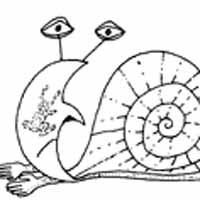
TEOYAOMQUI
TEPEYOLLOTL
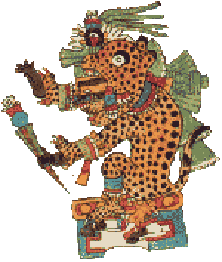
TEPOZTECATL
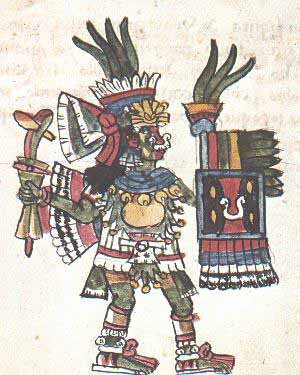
TEZCATLIPOCA
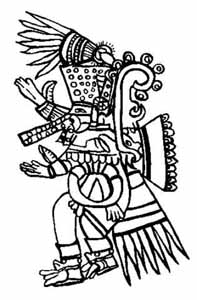
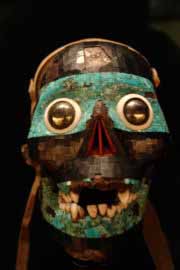
In Nahuatl mythology, Tezcatlipoca (tes-cat-lee-poh-ka) or "smoking mirror" was the god of the night, the north, temptation, sorcery, beauty and war. He was known by other descriptive names, such as Titlacauan (We His Slaves), Ipalnemoani (He by whom we live), Necocyaotl (Sower of Discord on Both Sides) and Tloque Nahuaque (Lord of the Near and Nigh) and Yohualli Eecatl (Night, Wind). When depicted he was usually drawn with a black stripe painted across his face, and is usually shown with his right foot replaced with a mirror made of obsidian or hematite.
Sometimes the mirror was shown on his chest. He would carry four arrows in his right hand to punish the sins of man with. His hair was black and in the style of a warrior, as well as carrying a shield and weapon. He wore twenty gold bells on his ankles, and on his right foot he wore a deer hoof, representing his swiftness and agility. He appears on the first page of the Codex Borgia carrying the 20 day signs of the calendar; in the Codex Cospi he is shown as a spirit of darkness, as well as in the Codex Laud and the Dresden Codex.
According to the Aztecs, he was also the god of discord and deceit as well as the god of robbers, but he was also the god of rulers, warriors and sorcery. He was associated with the notion of destiny or fate and with the jaguar, and was known for inciting wars between peoples.
He owned a mirror (Itlachiayaque - "Place From Which He Watches") that gave off smoke, killing his enemies; he saw everything and he punished wrong doers with illness and poverty, and rewarded good people with wealth and fame. He was the antithesis, rival, and eventually the twin of Quetzalcoatl. It was thought then when a baby was conceived, it was placed there by Tezcatlipoca to decided it¹s fate; the day you were born on prophesised the success or failure in your future. How the child looked was also attributed to the whim of Tezcatlipoca. It was thought that he would appear at night as a shrouded corpse, a bundle of ashes or a headless man with his chest and stomach slit open, and anyone who was brave enough to rip out his heart could demand a reward for returning it.
Attributes of both Tezcatlipoca and Quetzalcoatl originally came from pre-Aztec traditions of the Olmecs and the Toltecs. The Aztecs assimilated them in their religion, and the two deities were equated and considered twin gods.
They were both equal and opposed. Thus Tezcatlipoca was called "Black Tezcatlipoca", and Quetzalcoatl "White Tezcatlipoca". Mixcoatl was sometimes added to this complex as "Red Tezcatlipoca." Omacatl, Titlacahuan and Tezcatlanextia were also considered aspects of Tezcatlipoca; the four Tezcatlipocas were the sons of Ometecuhtli and Omecihuatl, lord and lady of the duality, and were the creators of all the other gods, as well as the world and man.
TLAHUIZCALPANTECUHTLI
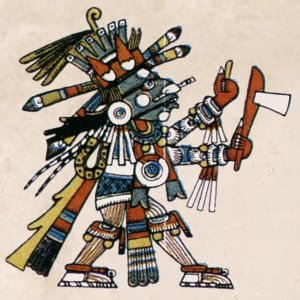
TLALOC
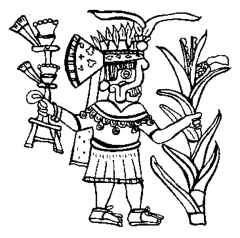
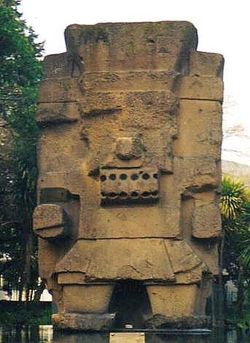
Tlaloc, also known as Nuhualpilli, was, in Aztec belief, the god of rain and fertility. He was greatly feared among the Aztecs, who drowned children to appease him. They believed that Tlaloc was responsible for both floods and droughts, and that he had been created by the other gods. He is commonly depicted as a goggle-eyed blue being with fangs. Human sacrifices were often made in his honor, usually children. Before the victims were actually sacrificed, their tears were collected in a ceremonial bowl, to serve as an offering. Tlaloc was also worshipped in pre-Aztec times, by the Teotihuacan and Toltec civilizations.
Tlaloc was first married to Xochiquetzal, a goddess of flowers, but then Tezcatlipoca kidnapped her. He later married the goddess Chalchiuhtlicue, "She of the Jade Skirt". In Aztec mythic cosmography, Tlaloc ruled the fourth layer of the 'Upper World", or heavens, which is called Tlalocan ("place of Tlaloc") in several Aztec codices, such as the Vaticanus A and Florentine codices. Described as a place of unending Springtime and a paradise of green plants, Tlalocan was the destination in the afterlife for those who died violently from phenomena associated with water, such lightning, drowning and water-borne diseases.
With Chalchiuhtlicue, he was the father of Tecciztecatl. He had an older sister named Huixtocihuatl. He ruled over the third of the five worlds in Aztec belief. In Salvadoran mythology, he was also the grandfather of Cipitio.
Tlalocan was the earthly paradise of Tlaloc, located in the East, the place of Light and Life. It was where the souls of those killed by lightning, dropsy, skin diseases, and those sacrificed to Tlaloc went.
The Rain God-God of Vegetation-Ruler of the South. In ancient Chichimec times may have been worshipped under the name of Tlalocateuctli, meaning "Land-lier-Lord". Tlalocateuctli was considered by Alcaron to be a metaphor for the owner of a sown field.
Known to the Olmec as "Epcoatl", meaning Seashell Serpent. There is speculation that this deity originated with the Olmec. Known to the Maya as Chac, to the Totonacs as Tajin, to the Mixtecs as Tzahui, to the Zapotecs as Cocijo and throughout Mesoamerica.
A water god probably one of the oldest gods worshiped as a result of the importance of rain for crop production. Called Choc by the Maya and Cocijo by the Mixtecs, the principal worship god of the Olmec culture. Tlaloc was not a creator God but one created by other Gods. His first wife Xochiquetzal, Goddess of flowers and love , was stolen from him by Tezcatlipoca. His second wife was the Goddess Matlolcueitl, "The Lady of the Green Skirts", an ancient name for the mountain known as Malinche, located in Tlaxcala.
Although a beneficent god Tlaloc certainly had the power to unleash floods, lightning and drought when angry. To please him children were sacrificed to him as well as prisoners dressed in his image. It is said that the more the babies and children cried the more Tlaloc was pleased. During the sacrifice the tears of the screaming children were seen as representations of falling rain, the more the children cried, the better the rain season.
Tlaloc is easily identified by his characteristic mask giving the impression of eyeglasses and a mustache. Blue is his dominant color and of his mask. His body and face are often painted black, and water is often depicted dripping from his hands. The name Tlaloc, derives from the term "tlalli", meaning earth, with the suffix "oc", meaning something that is on the surface. Townsend alludes to the fight of clouds welling up in canyons and hovering around mountaintop in the rainy season to explain this metaphor.
Those who died from drowning, lightning or things thought to be associated with water went to Tlacocan, the paradise of Tlaloc located in the South and was known as the place of fertility.
His home in Tenochtitlan was next to the same temple of the venerated Huitzilopochtli, where a special chamber was built. His statue was made of stone in the shape of a horrible monster. The image was dressed in red with a green feather headdress. A string of green beads called chalchihuitl, "jade", hung from his neck. His ears, arms, and ankles were adorned with bracelets of precious stones. Apparently no other idols in the Mexica city were adorned with as many precious jewels at Tlaloc. In his right hand was a representation of a purple wooden thunderbolt, in his left hand was a leather bag filled with copal. The idol was placed upon a green cloth draped over a dais. His body was sculpted as a man and the face like a monster.
Also known as Tlalteuctli, (Earth Lord). May have been known as Oztoteotl, (The God of Caves), who was principally worshipped in the Chalma area. In the codex Vaticanus, Tlaloc is depicted as living inside of a mountain.
Known by the Olmec as "Epcoatl", or Seashell Serpent.
An interesting ceremony to Tlaloc by his priests was for the priests to throw themselves into frigid lake waters at midnight and imitate the sound and splashing of water birds to the point of exhaustion. This was apparently done just to please Tlaloc. In another ritual a priest would climb a mountain naked(*18) and painted black, carrying fir boughs and a conch trumpet. He would chew tobacco and periodically blow the horn. After piercing his ears and thighs with spines(*19) to let blood(*20), he would retrace his steps stumblin
The direction of the rains Tlaloc sent were also of importance. The western rain was red colored from the sunset. This rain represented the richness of autumn. The southern rain was a rich blend of rain and summer fertility and considered a , Tlaloc's color.
The eastern rain was a golden rain which fell lightly over the crops making the crops grow, a promise of life. The north rain was a hail and thunder message from Tlaloc often bringing destruction. Snow and hail were thought of as representations of the bones of the past dead.
The temple to Tlaloc, on Mt. Tlaloc, is approximately at the 4000 meter level with views of the twin volcanoes Popocatepetl and Ixtaccihuatl and the entire valleys of Pueblo and Mexico. Mt. Tlaloc was located approximately twenty-five miles due east of Tenochtitlan and directly north of the twin volcanoes. In the Spring, at the height of the dry season, the leaders of Tenochtitlan, Tetzcoco, Tlacopan, and Xochimilco would make a pilgrimage to the shrine to call for rain from within the mountain.
While the Mexica leaders were conducting their ceremony, a large tree called "Father", or Tota, was erected near the great shrine to Tlaloc in Tenochtitlan and surrounded with small trees to symbolize a forest. An impersonator of Chalchiuhtlicue, Goddess of the sea and lakes, was selected to sit in the forest and symbolize the lake. As the leaders were returning, the great tree was felled and rafted out to the Pantitlan shrine, located in the center of the lake, where a great fleet of canoes met the returning leaders. The impersonator was then sacrificed, her blood poured into the water of the lake, jewelry given to the water of the lake, and the tree symbolically planted to indicate a renewal of life and growth. The tree was left to stand with the remains of trees planted in past years ceremonies.
Attendants of Tlaloc:
Resided in the mountains, where rain and clouds are formed. Not deities themselves but close enough. May be likened to devilish imps who served the rain god Tlaloc. The Tlaloque were worshiped in special ceremonies during the sixteenth month of the Aztec calendar, (Dec. 11-Dec. 30), known as Atemoztli, meaning "The Descent of Water". The Tlaloque were the bearers of the rattlestaff (chicahualilizti), "That Which Makes Things Strong". A signification of a male erect penis or a type of digging stick. The Tlaloque numbered four and lived in the halls of the great palace of Tlaloc, Tlalocan, the terrestrial paradise, and represented the four directions. On Tlaloc's orders one of the Tlaloque would take a particular jug and pour it over the world, thunder was thought to be the sound of the jugs breaking. The Mexica considered the Tlaloque to be brothers to the goddess of corn.
TLOQUE NAHUAQUE
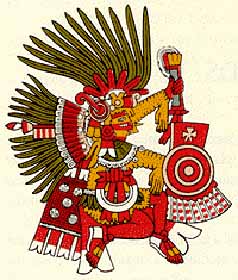
TONACATECUHTLI
TONATIUH

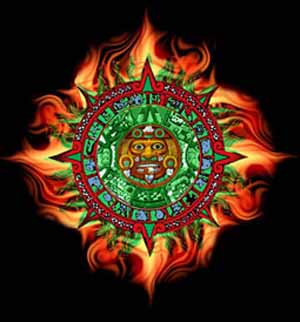
In Aztec mythology, Tonatiuh was the sun god. The Aztec people considered him the leader of Tollan, their heaven. He was also known as the fifth sun, because the Aztecs believed that he was the sun that took over when the fourth sun was expelled from the sky. According to their cosmology, each sun was a god with its own cosmic era. According to the Aztecs, they were still in Tonatiuh's era. According to the Aztec creation myth, the god demanded human sacrifice as tribute and without it would refuse to move through the sky. It is said that 20,000 people were sacrificed each year to Tonatiuh and other gods, though this number is thought to be inflated either by the Aztecs, who wanted to inspire fear in their enemies, or the Spaniards, who wanted to vilify the Aztecs. The Aztecs were fascinated by the sun and carefully observed it, and had a solar calendar second only in accuracy to the Mayans'. Many of today's remaining Aztec monuments have structures aligned with the sun.
He was a sun-god, and heavenly warrior; God of the Sun represented by the eagle. Poor and ill, Tonatiuh cast himself into the flames, and being burnt up, was resurrected. Daily Tonatiuh repeats his passage across the heavens, down into darkness, and back again into the sky. With him Tonatiuh carries all brave warriors who have died in battle and all brave women who have died in childbirth. The greatest heroes Tonatiuh carries with him to the greatest heights. to Tonatiuhican.
TONANTZIN
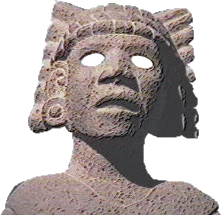
TZITZIMIME
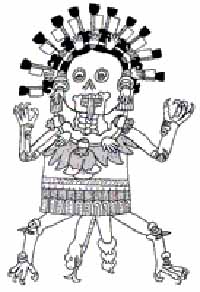
XILONEN
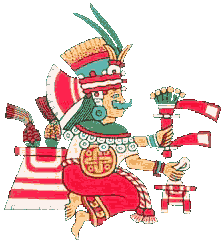
XIPE TOTEC
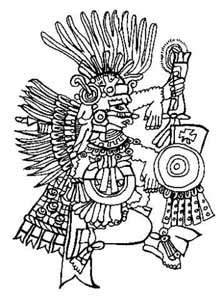
Annually, slaves were selected as sacrifices to Xipe Totec. These slaves were carefully flayed to produce a nearly whole skin which was then worn by the priests during the fertility rituals that followed the sacrifice. Some accounts indicate that a thigh bone from the sacrifice was defleshed and used by the priest to touch spectators in a fertility blessing. Paintings and several clay figures have been found which illustrate the flaying method and the appearance of priests wearing flayed skins.
XIUHTECUHTLI
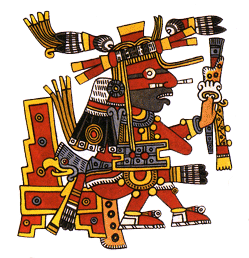

In Aztec mythology, Xiuhtecuhtli (also Huehueteotl, "old god") was the personification of life after death, warmth in cold (fire), light in darkness and food during famine. He was usually depicted with a red or yellow face and a censer on his head. His wife was Chalchiuhtlicue.At the end of the Aztec century (52 years), the gods were thought to be able to end their covenant with humanity. Feasts were held in honor of Xiuhtecuhtli to keep his favors, and human sacrifices were burned after removing their heart.
XOCHIPILLI
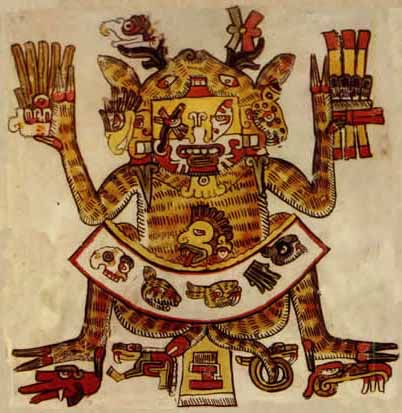
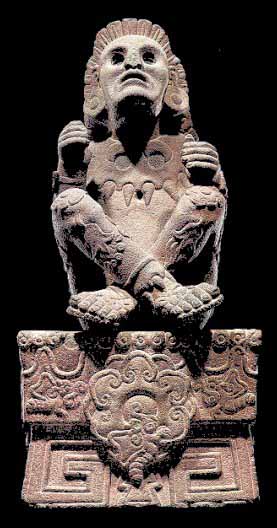
"Patroness of Erotic Love" "Goddess of the Flowering Earth". Celebrated during the "Farewell to the Flowers" festival signifying the coming of frost. This was a solemn festival. People would make merry and smell flowers knowing they were about to dry up and wither for the season. A feast in honor of the flowers would occur.
Xochiquetzal was also the divinity of painters, embroiders, weavers, silversmiths and sculptors.
The image of this deity was of wood in the shape of a young woman. A gold ornament was placed over her mouth and a crown of red leather in the form of a braid was placed on her head. Green bright feathered decorated this headband in the shape of horns.
She was dressed in a blue tunic adorned with woven flowers made from delicate feather work. Her arms were open as in the form of a woman dancing. Her idol was placed on a tall alter and her attendants were the same as those who tended Huitzilopochtli as her temple was small and had no specially assigned priests. This is one of the exceptions the Aztec made and were fond of sacrificing virgins to this goddess. The victim's legs were crossed after cutting out their hearts and then sent rolling down the steps of the temple. At the foot of the temple special priests took the bodies of the sacrificed virgins to the Ayauhcalli, "the house of the mist", which was a sort of cellar built especially for this sacrifice, where the bodies were kept.
A woman in the guise of Xochiquetzal was ritually killed and flayed and a priest wearing her skin would sit at the foot of the temple while area craftsmen dressed as monkeys, ocelots, dogs, coyotes, and jaguars would dance about her while she pretended to weave cloth. Each of the dancing craftsmen would carry in their hands a symbol of their craft, a painter his brush, etc.
Also refereed to as Precious Feather Flower-Goddess of Song, Dance, and Sexual Pleasure. Patron of prostitutes. Goddess of Artistry and Delight. In Duality she was also Macuilxochitl, a male representation.
God associated with maize and vegetation. Goddess of flowers, grains, and patroness of weavers. God of sculptors and embroiders. Quail and incense were often offered to this god and depending on the devotion fasting of from 20 - 80 days was common. People who were born on One Flower or Seven Flower were pre-destined to become good at these crafts and worship this god. Said to have afflicted those who displeased her with boils.
in legend she was taken to the underworld by Xolotl and ravaged. She also is said to have eaten forbidden fruit from an aphrodisiac tree and became the first female to submit to sexual temptation. She was expelled from paradise and the tree split into two. She transformed into Ixnextli, "Ashes in Eyes", a metaphor for being blinded by crying. Her pain at not being able to look into the sky that she once lived in is why men can not look directly into the sun.
Goddess of flowers and romantic love depicted with flowers in her head-dress and as a young married woman with a wrap around skirt and a Quechquimitl, or highly decorated type of poncho. Xochiquetzal's flower was the marigold. Today in early November Mexico celebrates the day of the dead, or "All Souls", in which the ground is strewn with marigolds, combining old and new customs. She may have been worshipped under the name Tonacacihuatl, meaning "Sustenance-Woman". Worshipped during the festivals of Matlalcueyeh, Huei Pachtli, and Macuilxochiquetzal.
XOCHIQUETZAL
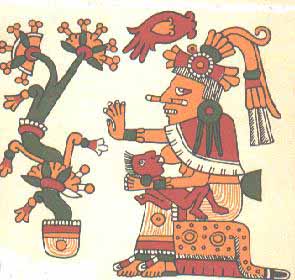
XOLOTL
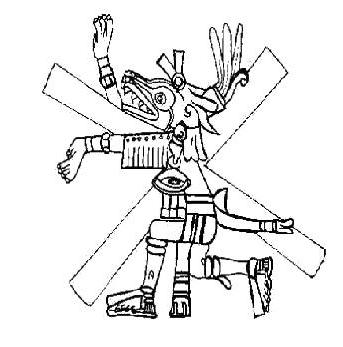
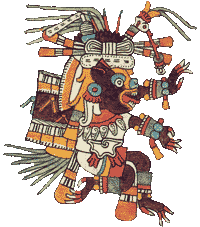
In Aztec and Toltec mythology, Xolotl ("The Animal", Lord of the Evening Star, Lord of the Underworld) was the god of lightning and a psychopomp, which is to say that he was the one who aided the dead on their journey to Mictlan, the afterlife.
Xolotl was also the god of fire and of bad luck. He was the twin of Quetzalcoatl, the pair being sons of the virgin Coatlicue, and was the evil personification of Venus, the evening star. He guarded the sun when it went through the underworld at night. He also brought forth humankind and fire from the underworld.
In art, Xolotl was depicted as a skeleton, a dog-headed man - "xolotl" can also mean "dog" in Nahuatl, the Aztec language - or a monster animal with reversed feet. He was also the patron of the Ulama game. He is identified with Xocotl as being the Aztec god of fire.
The axolotl, a type of salamander native to Mexico, is not directly named after the god. Instead, its name derives from the Nahuatl words for water ("atl") and dog (also "xolotl").Xoloitzcuintle is the official name of the Mexican Hairless Dog (also known as Perro Pelón Mexicano in Spanish), a canine species endemic to Central America dating back to Pre-Colombian times. This is one of many native dogs species in the Americas and it is often confused with the Peruvian Hairless Dog. The name Xoloitcuintle makes reference to Xolotl because, historically, one of this dog's missions was to accompany the dead in their journey into eternity. In spite of this prominent place in the mythology, the meat of the Xoloitcuintle was very much part of the diet of some of the ancient peoples of the region.
YACATECUHTLI
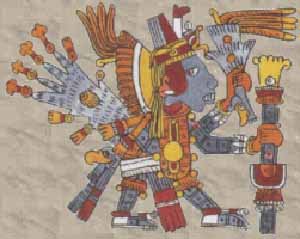
References:
Aztec Gods and Goddesses Wikipedia
Aztec Religion
ANCIENT AND LOST CIVILIZATIONS
CRYSTALINKS MAILING LIST, NEWSLETTER, UPDATES
ALPHABETICAL INDEX OF ALL FILES